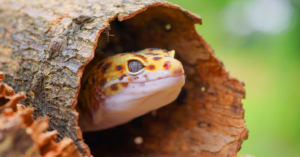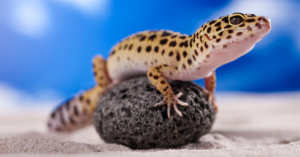Affiliate Disclosure
This article contains affiliate links, including links from the Amazon Associates Program and other affiliate networks. If you purchase through these links, I may earn a small commission at no extra cost to you. These commissions help support the site and allow me to continue providing valuable content on leopard gecko care. I only recommend products that I believe are high quality and beneficial for pet owners.
Leopard Gecko Fun Facts: Why These Little Lizards Make the Perfect Pet
Leopard geckos have an undeniable charm that makes them stand out among pet reptiles.

With their big, expressive eyes and gentle nature, they quickly win over reptile enthusiasts and first-time pet owners alike. Unlike other geckos, they have movable eyelids, allowing them to blink and close their eyes like mammals. Their ability to recognize patterns and routines makes them more interactive than many expect. Whether waving their tails in excitement or curiously investigating their surroundings, these lizards prove that reptiles can be just as engaging as traditional pets. They are easy to care for and full of personality and make excellent companions for those willing to understand their needs.

Leopard geckos thrive in structured environments where they feel safe and secure. A consistent feeding routine, proper habitat setup, and gentle handling help build trust between the gecko and the owner. Over time, they begin to recognize their caregivers, making the bond even more rewarding.
Despite their independent nature, these geckos display behaviors that hint at curiosity and connection. They watch their owners, follow movements, and even react to voices. This makes them fascinating to observe and interact with.
Once you understand their habits and quirks, it’s easy to see why leopard geckos are one of the most popular pet reptiles in the world.
Their Big, Expressive Eyes and Tiny Smiles
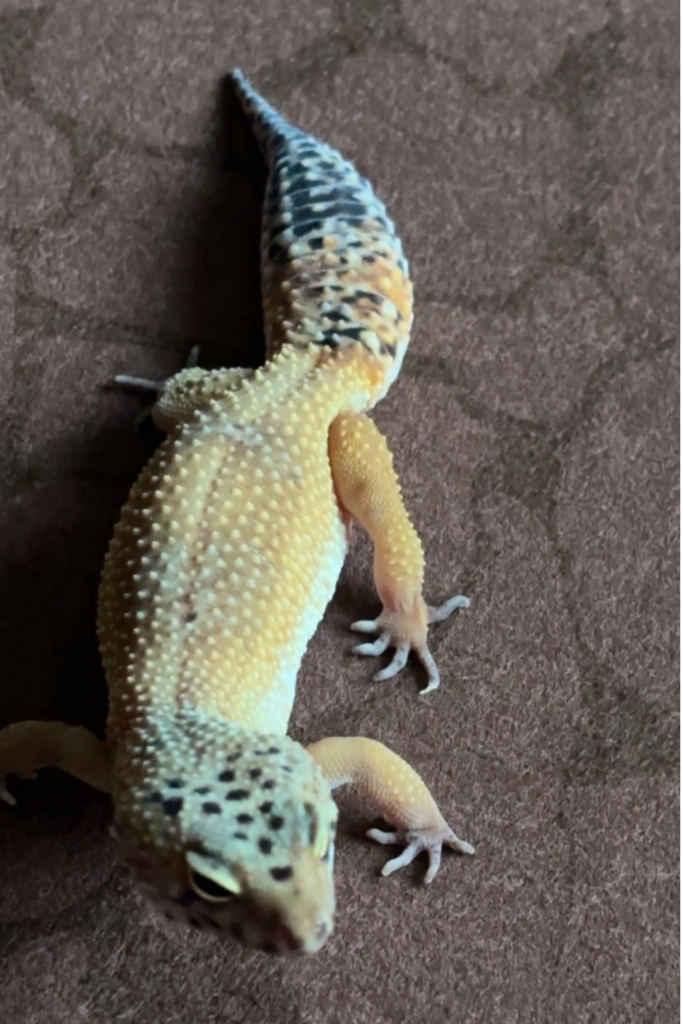
Leopard geckos have some of the most captivating eyes in the reptile world. Unlike most other geckos, they possess fully functional eyelids, allowing them to blink, close their eyes, and even sleep like we do. But these little creatures have more than just cute eyes—they have a visual superpower that sets them apart from other reptiles.
Reason #1: Their Eyelids Make Them Stand Out in the Gecko World
Most geckos lack eyelids, so they must lick their eyeballs to keep them clean. But leopard geckos? They’re different. Their movable eyelids allow them to blink, protecting their eyes from dust and debris. This adaptation is crucial because leopard geckos inhabit dry, rocky deserts where dirt and sand constantly swirl around. Herpetologists say this trait links them more closely to traditional lizards like iguanas than to their sticky-toed gecko cousins.
Reason #2: They Have Super-Powered Night Vision
Ever wonder how leopard geckos hunt so effectively at night? Their eyes are up to 350 times more sensitive to light than human eyes. That means even in near-total darkness, they can still see their prey scuttling across the sand. And here’s the kicker—they don’t just see in black and white. Studies suggest they can perceive color in low-light conditions, a rare ability shared with only a handful of nocturnal predators, including cats and owls.
Reason #3: Their Smiling Faces Create an Emotional Connection
Their large, round eyes and upturned mouths give them a perpetual “smiling” expression. While this is just a quirk of their facial structure, many owners report that their geckos seem to have personalities—some appearing curious, others mischievous, and others even looking downright grumpy. This emotional connection is part of why leopard geckos are among the most popular pet reptiles worldwide.
Bottom Line: Those big, expressive eyes and tiny smiles aren’t just for show. They play a vital role in survival, hunting, and bonding with their environment (and human caretakers).
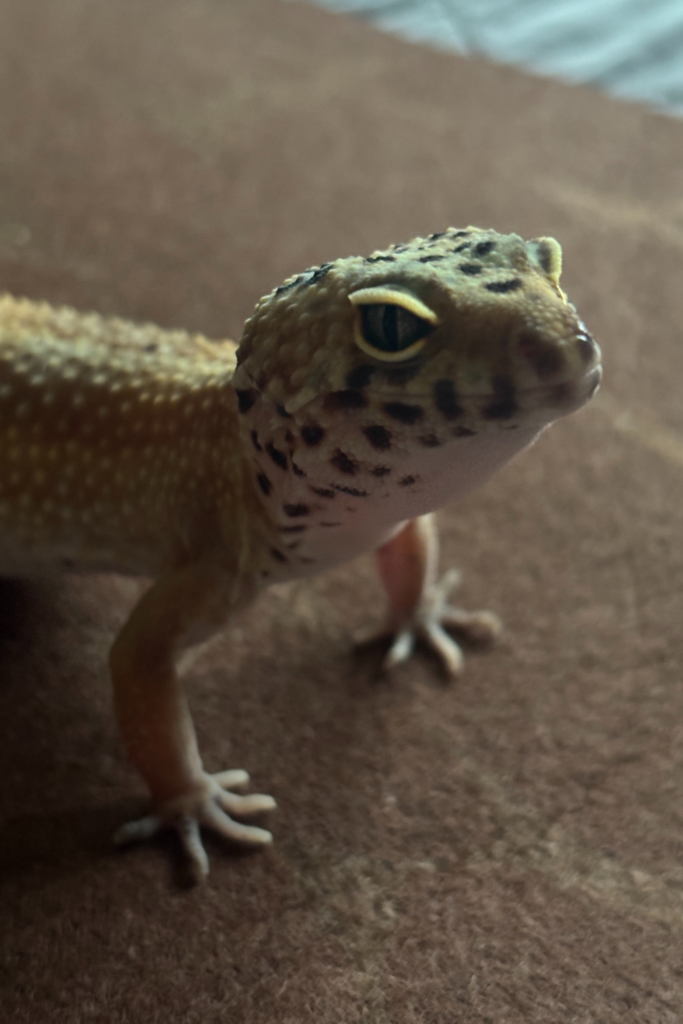
They Wave Their Tails When Excited
Leopard geckos don’t just use their tails for balance—they use them to communicate, defend, and even intimidate. If you’ve ever seen a gecko slowly wagging its tail like a cat before pouncing, you’ve witnessed one of the most fascinating behaviors in the reptile kingdom.
Reason #1: Tail Waving is a Key Hunting Strategy
Before striking at their prey, leopard geckos slowly wave their tails side to side, almost like a snake hypnotizing its next meal. This movement confuses insects and may serve as a distraction before the gecko lunges. In the wild, every calorie counts, so wasting energy on a missed strike could mean the difference between thriving and starving. According to reptile experts, this behavior is a built-in mechanism that increases their hunting success.
Reason #2: It’s a Built-in Defense Mechanism
Tail-wagging isn’t always a sign of excitement—sometimes, it’s a warning. If a leopard gecko feels threatened, it might rapidly shake its tail, clearly saying, “Back off!” This is especially common when two geckos meet, particularly males. The tail shake can be a territorial display, warning rivals to stay away. If intimidation fails, the gecko has a final, dramatic trick—it can drop its tail entirely and make a run.
Reason #3: It’s a Form of Communication with Other Geckos
Leopard geckos don’t have vocal cords like mammals, so they rely on body language. A slow, deliberate tail wave directed at another gecko usually means friendly curiosity or mating interest. But a fast, aggressive shake? That’s a fight waiting to happen. Understanding these tail signals is crucial for owners housing multiple geckos together. A misread sign could result in territorial disputes, stress, or even injury.
Bottom Line: Tail-wagging is not just adorable—it’s a survival tool. Whether stalking a cricket, fending off a rival, or signaling to a potential mate, leopard geckos use their tails as a powerful form of non-verbal communication.
They Recognize Their Owners Over Time
Reptiles aren’t known for their emotional connections, but leopard geckos break that stereotype. Many owners report that their geckos recognize them, respond to their presence, and even show signs of trust over time. While they may not bond like a dog or cat, these little lizards are smarter than you think.
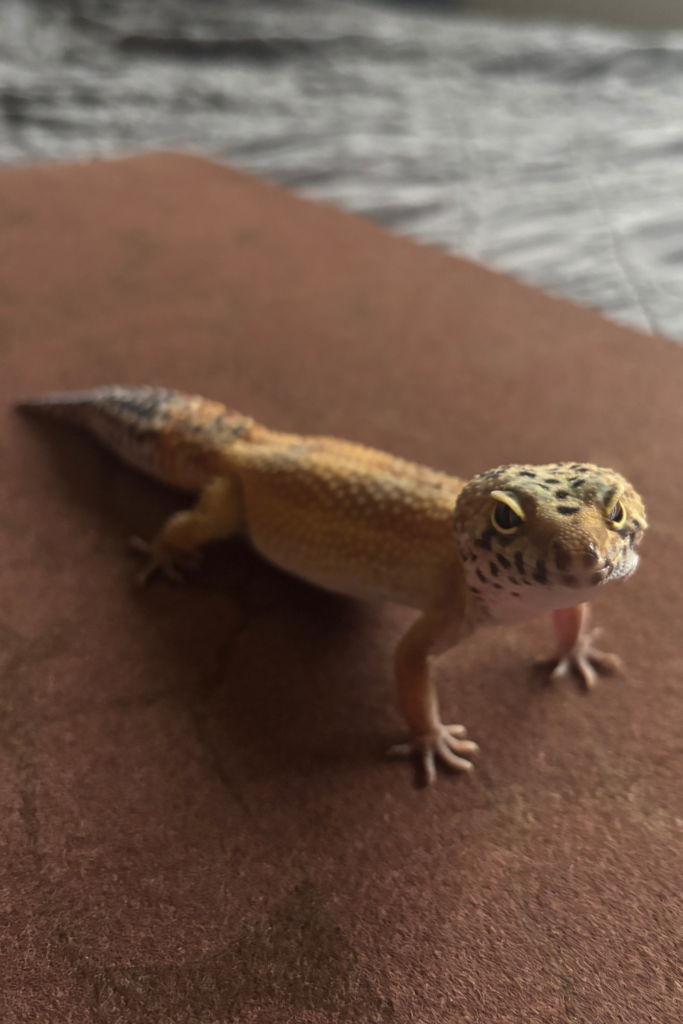
Reason #1: They Associate Their Owners with Positive Experiences
Leopard geckos may not wag their tails when they see you (unless they’re in hunting mode), but they do learn to recognize patterns—especially regarding food. If you consistently feed them at the same time every day, they’ll begin associating you with mealtime. Many geckos will start coming to the front of their enclosures when they see their owner, eagerly waiting for their next meal. This learned behavior is a strong sign of recognition and routine memory.
Reason #2: They React Differently to Familiar vs. Unfamiliar People
Here’s where it gets interesting—geckos seem to react differently to their owners than strangers. A well-socialized leopard gecko will often approach its trusted caretaker but stay hidden or act skittish when faced with someone new. While this isn’t the same as a mammal’s emotional attachment, it demonstrates learned trust. Scientists believe that reptiles can remember specific individuals based on scent, voice vibrations, and movement patterns.
Reason #3: They Show Signs of Comfort and Trust with Their Owners
A stressed gecko hides, avoids handling, or may even drop its tail. But a relaxed, trusting gecko climbs onto its owner’s hand, explores its surroundings, and remains calm during interactions. Some geckos even seek out human contact, crawling onto their owner’s arm during feeding or responding positively to gentle handling. This behavior proves that, while they may not “love” you in the traditional sense, they recognize you as a safe and familiar presence.
Bottom Line: Leopard geckos aren’t just instinct-driven hunters—they’re intelligent enough to recognize their owners. Over time, with consistent handling and feeding, they build trust and display behaviors that suggest familiarity and even curiosity.
They Can Learn Routines, Like Feeding Times
Leopard geckos may seem like simple creatures, but their ability to recognize patterns and adapt to schedules proves otherwise. In captivity, these little lizards quickly learn routines, especially feeding, handling, and light cycles. This behavior isn’t just convenient for owners—it’s a survival advantage in the wild.
Reason #1: They Anticipate Feeding Times
If you feed your leopard gecko at the same time every day, don’t be surprised when you find them waiting near their food dish or at the front of their enclosure. Many owners report that their geckos become more active, flicking their tongues or even waving their tails in anticipation. This is because leopard geckos have an internal clock that helps them recognize patterns in their environment. In the wild, this instinct helps them hunt at optimal times, ensuring they have enough energy to survive.
Reason #2: Routine Reduces Stress and Improves Health
Reptiles thrive on stability. Sudden changes in their environment—like unpredictable feeding, inconsistent lighting, or random handling—can cause stress. A gecko that learns a consistent feeding and handling routine will feel more secure, leading to:
- Better digestion (stress can cause them to refuse food).
- More relaxed handling experiences (familiarity builds trust).
- A stronger immune system (stress weakens their defenses).
By keeping a structured schedule, owners can help their geckos feel safe and comfortable.
Reason #3: They Learn to Recognize Handling Routines
Leopard geckos are naturally shy, but with consistent and gentle handling, they learn to trust human interaction. If you pick them up the same way each time—slow, steady movements with no sudden grabs—they begin to expect and tolerate handling rather than seeing it as a threat. Over time, many geckos even crawl onto their owner’s hand voluntarily, signaling they’re comfortable with the routine.
Bottom Line: Leopard geckos are creatures of habit, and when given a structured schedule, they thrive in captivity. Predictability helps them stay healthy, stress-free, and comfortable in their environment.
Their Playful Personality Makes Them Entertaining to Watch
Leopard geckos may not chase balls like dogs or climb curtains like cats, but they have their own brand of playful curiosity that keeps owners entertained. From exploring their enclosures to chasing their own tails, these little reptiles can be surprisingly animated when given the right environment.
Reason #1: They Are Naturally Curious and Love to Explore
Leopard geckos are incredibly inquisitive. Place a new object in their enclosure—like a rock, a small hide, or even your hand—and watch them immediately investigate. They use their tongues to taste their surroundings, much like snakes do, and they’ll often climb, dig, or even push things around to satisfy their curiosity. In the wild, this behavior helps them find food, avoid predators, and locate the best hiding spots.
Reason #2: They Engage in Playful Behaviors
While “play” in reptiles isn’t the same as in mammals, leopard geckos do exhibit behaviors that look remarkably fun-loving:
- Some geckos will chase their own tails or flick them in excitement.
- Others seem to interact with their reflections, mistaking them for another gecko.
- Some will even “hunt” moving shadows, lunging at anything that looks like potential prey.
This kind of activity isn’t just amusing—it’s essential for mental stimulation and overall well-being.
Reason #3: They React to Their Owners in Surprising Ways
Many leopard gecko owners report their pets doing unexpectedly interactive things, such as:
- Watching them from inside their enclosure, as if studying their behavior.
- Following fingers moving outside the glass, curious about the movement.
- Climbing onto a hand after a familiar routine, showing trust and recognition.
While they aren’t social like a dog, leopard geckos develop their own quirky personalities, making them endlessly fun to observe.
Bottom Line: With their curiosity, playful movements, and surprising interactions, leopard geckos prove that reptiles can be just as entertaining as traditional pets. Watching them explore, react, and engage with their environment makes them one of the most enjoyable reptile companions to own.
These 5 Leopard Gecko Fun Facts Prove These Lizards Are the Perfect Pet
Leopard geckos aren’t just cute—they’re full of personality, intelligence, and fascinating behaviors. From their big, expressive eyes to their tail-waving excitement, these little reptiles bring joy to owners in ways few expect. Whether you’re looking for a pet that recognizes you, learns routines, or simply entertains you with its quirky antics, a leopard gecko might be the perfect companion.
Thinking of getting one? Do your research, set up a proper habitat, and get ready for one of the most rewarding reptile experiences you can have!


